|
|
|
Sort Order |
|
|
|
Items / Page
|
|
|
|
|
|
|
| Srl | Item |
| 1 |
ID:
127871


|
|
|
|
|
| Publication |
2014.
|
| Summary/Abstract |
In order to meet its 2050 target of 80% carbon emissions reduction, the UK is facing a challenge of restructuring its energy system, possibly by introducing more decentralised energy (DE) systems.Following semi-structured interviews, four exemplar international cases have been critiqued in order to investigate the variety and interrelationship of the drivers and barriers involved during their implementation, and then compared with the barriers and drivers that can potentially affect the implementation of similar projects in the UK context. The impacts of the barriers on the outcomes of these projects were evaluated, and recommendations were presented on overcoming these barriers if replicating similar projects in the UK context. Governance drivers play the most significant role, whereas financial drivers (commonly believed to be crucial), are deemed to play a lesser role. Social, governance and financial barriers rather than technological barriers constitute the central problem areas for the increased adoption of DE. The drivers and barriers experienced in the international cases were similar to those anticipated in the UK. The case studies present a high potential for replication and scaling up in the UK context and demonstrate that the increased implementation of DE systems could also enhance social and governance benefits.
|
|
|
|
|
|
|
|
|
|
|
|
|
|
|
|
| 2 |
ID:
176793
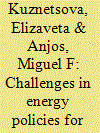

|
|
|
|
|
| Summary/Abstract |
The accessibility and reducing cost of distributed renewable energy sources are stimulating the emergence of small-scale residential prosumers who can produce and consume electricity. This may lead to various scenarios. Such prosumers may increase the uncertainty of consumption behavior, reduce consumption from the grid, and eventually disconnect from the grid. However, they may remain connected, and their energy potential can provide flexibility for the overall system. Current policy in some jurisdictions promotes disconnection through tax increases, grid charges, and other non-commodity costs. In particular, in Ontario (Canada) only 8.7% of the typical electricity bill covers the cost of energy and power; the remainder subsidizes governmental energy-procurement contracts, compensates the grid, pays for environmental initiatives, and covers other taxes. The situation is aggravated by a lack of a global vision for the energy system and of coordinated actions to achieve this vision. We support the preferred scenario in which prosumers remain connected to the grid. As an alternative to Ontario's current attempts to artificially slow the increase in electricity prices, we present an extended critical survey of energy policies to motivate a thoughtful reconsideration of current schemes for the economic integration of prosumers in the energy system.
|
|
|
|
|
|
|
|
|
|
|
|
|
|
|
|
| 3 |
ID:
126841


|
|
|
|
|
| Publication |
2014.
|
| Summary/Abstract |
The energy sector is the biggest contributor of anthropogenic emissions of greenhouse gases into the atmosphere in Iran. However, abundant potential for implementing low-carbon technologies offers considerable emissions mitigation potential in this sector, and technology transfer is expected to play an important role in the widespread roll-out of these technologies. In the current work, globally existing low-carbon energy technologies that are compatible with the energy sector of Iran are identified and then prioritised against different criteria (i.e. Multi Criteria Decision Analysis). Results of technology prioritisation and a comprehensive literature review were then applied to conduct a SWOT analysis and develop a policy package aiming at facilitating the transfer of low carbon technologies to the country. Results of technology prioritisation suggest that the transport, oil and gas and electricity sectors are the highest priority sectors from technological needs perspective. In the policy package, while fuel price reform and environmental regulations are categorised as high priority policies, information campaigns and development of human resources are considered to have moderate effects on the process of technology transfer.
|
|
|
|
|
|
|
|
|
|
|
|
|
|
|
|
| 4 |
ID:
124085


|
|
|
|
|
| Publication |
2013.
|
| Summary/Abstract |
Jacobson et al. (2013) recently published a paper arguing the feasibility of meeting all of the energy demands in New York State with wind, solar, and water resources. In this forum we suggest that the authors do not present sufficient analysis to demonstrate the technical, economic, and social feasibility of their proposed strategy.
|
|
|
|
|
|
|
|
|
|
|
|
|
|
|
|
| 5 |
ID:
116163


|
|
|
|
|
| Publication |
2012.
|
| Summary/Abstract |
This article examines the role of environmental change in conducting intelligence assessments, and the important role in integrating scientific data with background assumptions behind military and security planning. Tracing the development of environmental security concepts, recent military and intelligence interest in climate and environmental changes are based on practical concerns over critical vulnerabilities of infrastructure, energy supplies, and system stability. Examples from Central Asia illustrate the cascading nature of environmental security risks, particularly with water and energy systems. The discussion follows with how scenarios and risk assessments can be integrated with concepts from environmental net assessments, and why traditional assumptions of probabilities, uncertainties and secrecy may be misleading. It is essential to understand not only how extreme future changes might be, but what capabilities we and allies posses to adapt to environmental-related hazards.
|
|
|
|
|
|
|
|
|
|
|
|
|
|
|
|
| 6 |
ID:
124358


|
|
|
|
|
| Publication |
2013.
|
| Summary/Abstract |
The Kazakh energy system is less efficient than most other national energy systems. The electricity and heat sub-systems account for about one half of the difference between the primary energy supply and the final consumption. After reviewing the technology chains of electricity and heat generation, transmission and distribution and their organisation, this paper presents scenario studies on the possible evolutions of these sub-systems to 2030. It describes the representation of the heat and electricity chains in the MARKAL-TIMES-Kazakhstan model, with focus on the residential and commercial sectors, and some key input data assumptions. The main scenario drivers are the need to improve the efficiency of electricity and heat in the residential and commercial sectors and to reduce GHG emissions from the energy system as a whole. The model results point to the possibility of achieving cost effective energy efficiency improvement of more than 2% per annum and it would entail a net economic advantage to the country.
|
|
|
|
|
|
|
|
|
|
|
|
|
|
|
|
| 7 |
ID:
191219


|
|
|
|
|
| Summary/Abstract |
Hydrogen can be key in the energy system transition. We investigate the role of offshore hydrogen generation in a future integrated energy system. By performing energy system optimisation in a model application of the Northern-central European energy system and the North Sea offshore grid towards 2050, we find that offshore hydrogen generation may likely only play a limited role, and that offshore wind energy has higher value when sent to shore in the form of electricity. Forcing all hydrogen generation offshore would lead to increased energy system costs. Under the assumed scenario conditions, which result in deep decarbonisatiton of the energy system towards 2050, hydrogen generation – both onshore and offshore – follows solar PV generation patterns. Combined with hydrogen storage, this is the most cost-effective solution to satisfy future hydrogen demand. Overall, we find that the role of future offshore hydrogen generation should not simply be derived from minimising costs for the offshore sub-system, but by also considering the economic value that such generation would create for the whole integrated energy system. We find as a no-regret option to enable and promote the integration of offshore wind in onshore energy markets via electrical connections.
|
|
|
|
|
|
|
|
|
|
|
|
|
|
|
|
| 8 |
ID:
127267


|
|
Heat roadmap Europe: combining district heating with heat savings to decarbonise the EU energy system
/ Connolly, D; Lund, H; Mathiesen, B.V; Werner, S, Möller, B, Persson, U, Boermans, T, Trier, D, Ostergaard, PA, Nielsen, S
|

|
|
|
|
| Publication |
2014.
|
| Summary/Abstract |
Six different strategies have recently been proposed for the European Union (EU) energy system in the European Commission's report, Energy Roadmap 2050. The objective for these strategies is to identify how the EU can reach its target of an 80% reduction in annual greenhouse gas emissions in 2050 compared to 1990 levels. None of these scenarios involve the large-scale implementation of district heating, but instead they focus on the electrification of the heating sector (primarily using heat pumps) and/or the large-scale implementation of electricity and heat savings. In this paper, the potential for district heating in the EU between now and 2050 is identified, based on extensive and detailed mapping of the EU heat demand and various supply options. Subsequently, a new 'district heating plus heat savings' scenario is technically and economically assessed from an energy systems perspective. The results indicate that with district heating, the EU energy system will be able to achieve the same reductions in primary energy supply and carbon dioxide emissions as the existing alternatives proposed. However, with district heating these goals can be achieved at a lower cost, with heating and cooling costs reduced by approximately 15%.
|
|
|
|
|
|
|
|
|
|
|
|
|
|
|
|
| 9 |
ID:
127269


|
|
|
|
|
| Publication |
2014.
|
| Summary/Abstract |
Hourly demand response tariffs with the intention of reducing or shifting loads during peak demand hours are being intensively discussed among policy-makers, researchers and executives of future electricity systems. Demand response rates have still low customer acceptance, apparently because the consumption habits requires stronger incentive to change than any proposed financial incentive. An hourly CO2 intensity signal could give customers an extra environmental motivation to shift or reduce loads during peak hours, as it would enable co-optimisation of electricity consumption costs and carbon emissions reductions. In this study, we calculated the hourly dynamic CO2 signal and applied the calculation to hourly electricity market data in Great Britain, Ontario and Sweden. This provided a novel understanding of the relationships between hourly electricity generation mix composition, electricity price and electricity mix CO2 intensity. Load shifts from high-price hours resulted in carbon emission reductions for electricity generation mixes where price and CO2 intensity were positively correlated. The reduction can be further improved if the shift is optimised using both price and CO2 intensity. The analysis also indicated that an hourly CO2 intensity signal can help avoid carbon emissions increases for mixes with a negative correlation between electricity price and CO2 Intensity.
|
|
|
|
|
|
|
|
|
|
|
|
|
|
|
|
| 10 |
ID:
118058
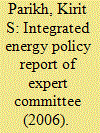

|
|
|
| 11 |
ID:
179727
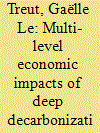

|
|
|
|
|
| Summary/Abstract |
To cap global warming below 2◦C, countries are urged to upscale their climate commitments and develop national deep decarbonization (DD) strategies for the energy system. But, fast and deep transformations will have wide-ranging economic implications at the macroeconomic level, in energy industries, and also in other sectors. Such impacts need to be understood by policy-makers. This paper develops an original integrated approach based on loading consolidated energy pathways into a multi-sector economy-wide model to assess within a consistent framework the multi-level economic impacts of the DD strategies. The method is applied to Argentina and gives representative insights into the global challenge to move towards a low-carbon economy. Our results show key multi-level impacts of shifting from a ‘reference’ to a DD pathway by 2050. In energy industries, value-added and employment shift from fossil fuel to low-carbon power industries. Aggregated GDP and welfare impacts are limited but incremental investments are significant at the macroeconomic level, with indirect and induced impacts across the economy. It includes net job creations in upstream industries that supply low-carbon infrastructures, but also risks of job losses in exposed sectors. Eventually, our approach highlights enabling conditions and possible block points to lift to trigger the transition.
|
|
|
|
|
|
|
|
|
|
|
|
|
|
|
|
| 12 |
ID:
137206


|
|
|
|
|
| Summary/Abstract |
China has established a petition system to elicit information about grievances. However, the petition system may have perverse effects because it also reveals to the center the failure of local-level officials to resolve those grievances. Anecdotal accounts suggest that local officials have incentive to silence petitioners, often with the use of repression. In this article we study whether non–regime threatening petitions would provoke local governments' coercive response. To tackle the endogenous relationship between petition and repression, we take advantage of a natural experiment afforded by a change in hydroelectricity policy in China. In particular, we use provincial hydropower outputs as an instrument to identify citizen petitions. We find that citizen petitions significantly increase a province's spending on its repressive apparatus. The results suggest a paradoxical outcome of China's petition system: while it may help reduce the national authority's use of repression, it has caused an explosion of repression within the authoritarian system as a whole.
|
|
|
|
|
|
|
|
|
|
|
|
|
|
|
|
| 13 |
ID:
073572
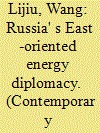

|
|
|
| 14 |
ID:
150000


|
|
|
|
|
| Summary/Abstract |
This paper simulates the medium- and long-term impact of proposed and expected energy policy on the environment and on the Mexican economy. The analysis has been conducted with a Multi-sector Macroeconomic Model for the Evaluation of Environmental and Energy policy (Three-ME). This model is well suited for policy assessment purposes in the context of developing economies as it indicates the transitional effects of policy intervention. Three-ME estimates the carbon tax required to meet emissions reduction targets within the Mexican “Climate Change Law”, and assesses alternative policy scenarios, each reflecting a different strategy for the recycling of tax revenues. With no compensation, the taxation policy would reduce CO2 emissions by more than 75% by 2050 with respect to Business as Usual (BAU), but at high economic costs. Under full redistribution of carbon tax revenues, a double dividend arises: the policy appears beneficial both in terms of GDP and CO2 emissions reduction.
|
|
|
|
|
|
|
|
|
|
|
|
|
|
|
|
| 15 |
ID:
127210
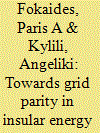

|
|
|
|
|
| Publication |
2014.
|
| Summary/Abstract |
Grid parity is defined as the threshold at which a grid-connected renewable energy sources (RES) system supplies electricity to the end user at the same price as grid-supplied electricity. Predictions from the 2006 time-frame expected retail grid parity for solar in the 2016 to 2020 era, but due to rapid downward pricing changes, more recent calculations have forced dramatic reductions in time scale, and the suggestion that solar has already reached grid parity in a wide variety of locations. This study presents aspects of achieving grid parity in insular energy systems, based on a case study applied in Cyprus. The analysis presents the variation of the manufacturing cost, the selling price of the produced energy, and the performance of the solar panels to examine the conditions of accomplishing grid parity event. It is also concluded that grid parity may be easier achieved in insular energy systems due to the higher cost of primary energy.
|
|
|
|
|
|
|
|
|
|
|
|
|
|
|
|
| 16 |
ID:
149914
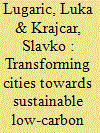

|
|
|
|
|
| Summary/Abstract |
Recognized as implementation actors of operative measures for transition towards a low carbon economy, cities must establish a development roadmap integrating local resources with local energy development plans. A systematic approach does not exist yet and cities develop their plans individually, which is difficult for small and medium sized cities due to limited development capacities. Conventional city planning approaches do not integrate considerations on energy, economy and environment in transition plans in an easily comparable way, yet making decisions with regards to these parameters is vital to determine outcomes of planned developments on future sustainability of the city.
|
|
|
|
|
|
|
|
|
|
|
|
|
|
|
|
| 17 |
ID:
180156
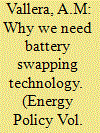

|
|
|
|
|
| Summary/Abstract |
Energy and transport must lead the transition to a low-carbon economy, weaning their dependence on fossil fuels via massive renewable generation and electrification of transport. A major challenge is the power system imbalance between generation and demand due to the higher fraction of non-dispatchable renewable generation such as solar photovoltaic or wind. Electric mobility will lean heavily on the power system but may contribute to mitigate the imbalance problem. This work focuses precisely on the impact of different models for future road mobility in a decarbonized power system, ranking the merits of each solution. The models considered are plug-in, plug-in and catenaries, plug-in and hydrogen, and battery swapping. We show that battery swapping, the least studied model so far, is superior to the other three in all semi-quantitative criteria of merit. We conclude our analysis with implications for energy policy and examples of public policies that could boost the adoption of this model, which has huge implications both for the mobility industry and for power systems.
|
|
|
|
|
|
|
|
|
|
|
|
|
|
|
|
|
|
|
|
|